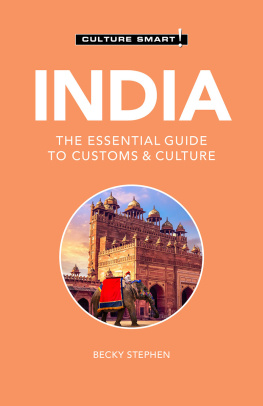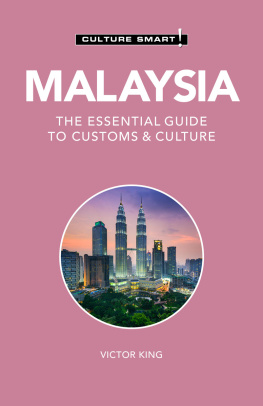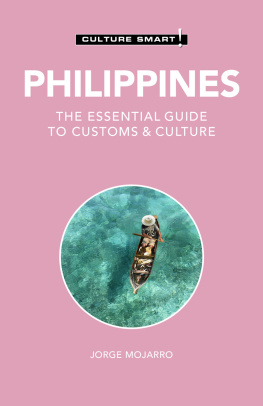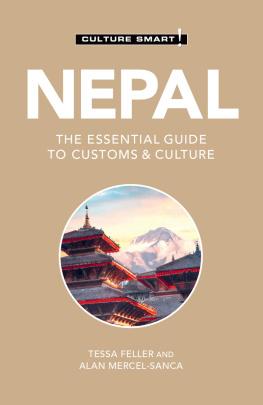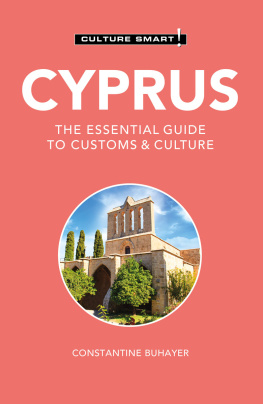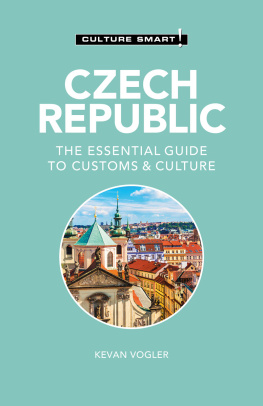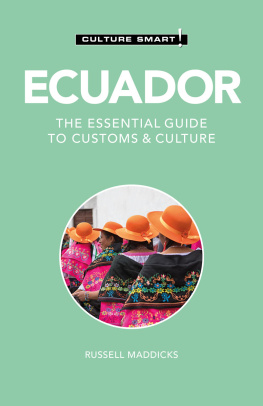
The real voyage of discovery consists not in seeking new landscapes, but in having new eyes.
Adapted from Marcel Proust, Remembrance of Things Past.
ISBN 978 1 78702 900 2
British Library Cataloguing in Publication Data
A CIP catalogue entry for this book is available from the British Library
First published in Great Britain
by Kuperard, an imprint of Bravo Ltd
59 Hutton Grove, London N12 8DS
Tel: +44 (0) 20 8446 2440
www.culturesmart.co.uk
Inquiries:
Design Bobby Birchall
Printed in Turkey
The Culture Smart! series is continuing to expand. All Culture Smart! guides are available as e-books, and many as audio books. For further information and latest titles visit www.culturesmart.co.uk
ABOUT THE AUTHOR
BECKY STEPHEN was born in the US as an air force brat, growing up in several states, as well as in England. Long fascinated by Indian culture and philosophy, Becky moved to India in 1988 to study Hindi at Banaras Hindu University, Varanasi. She met her South Indian husband there and ended up living in Varanasi for five years.
Becky has a Masters in Intercultural Studies from Fuller Theological Seminary, Pasadena, California, and has developed and led cross-cultural and other training programs and events in the US, India, Eurasia, Europe, and the Arabian Peninsula. After working for three years in Dubai as a management consultant and cross-cultural trainer, she moved with her husband and son to Atlanta, Georgia, where she trains and supervises Americans on long-term international assignments.
COVID-19
The coronavirus pandemic of 2020 affected millions of people around the world, causing unprecedented social and economic disruption. As the impact of this global crisis continues to unfold, in many countries social norms are being challenged, and enduring changes will be reflected in future editions of Culture Smart! titles.
CONTENTS
MAP OF INDIA

INTRODUCTION
India. The name instantly evokes associations and images in our minds. India has painted its colors on nearly every aspect of modern Western life. The food we eat, how we decorate our homes, what we wear, how we exercise, the movies we watch, the technology we use, and the religious options available to us have all been influenced by the many cultures and peoples of India. Indian languages have even entered our vocabulary: pundit, jodhpurs, and pajamas were Hindi words taken up by the British Raj; catamaran, pariah, and curry are Tamil contributions.
Seen from afar, perceptions of India may be based on overwhelming statistics on population and snapshots of poverty; technological competition in the global market; exotic art forms; and ancient history. All this is true. But at its heart, India is its people. Mother Indias nearly 1.4 billion children are as varied and colorful as the spice markets of Old Delhi. Each region, caste, and community has its own culture, reflecting unique histories shaped by conquest, creativity, and religion, expressed in distinct languages, social customs, art forms, and expectations of life.
In the face of five-thousand-year-old traditions, India is changing. Yet, despite enormous changes, in many ways it remains the samea total sensory experience. The chaos and beauty of color and sound, the language shifts every ten miles, the household variations of spice and spiciness, the insistent smells of everyday life lived very much in public, and the invasion of personal space will challenge the most experienced traveler. But it is in surrender to your senses that you begin to embrace the essence of India.
As you experience India up close, you will begin to understand something of the seemingly infinite capacity of Indians to live with paradox. The spectacle of Indias proud traditions and the Indians love for their land is commingled with tensions and prejudices rooted in conquests and rivalries long past. Ancient temples decorated with intricate sculptures may be plastered with signs advertising the latest technologies. You will smell the burgeoning slums that have been part of the rapid urbanization of the last century, and meet an affluent middle class that was nonexistent before the last few decades. Youll taste the metallic tang of pollution as your auto rickshaw darts through traffic, competing with delicious aromas steaming from the vats of street vendors.
Steeped in tradition, exceptionally fatalistic, and intensely passionate about their culture, Indians are some of the most ingenious, adventurous, and creative people on the planet. Warm and friendly, most will respond to your interest in them and their country with generosity and genuine friendship. But they also have indelible ties to family and community that form boundary lines and determine decisions that do not always seem reasonable from the outside.
Visitors responses to India can be as extreme as the people and places they encounter there. This book aims to make you aware of the basic values and behavioral norms, to show you how to navigate cultural differences and connect with real people, and to offer insights into the endlessly fascinating place that is India.
KEY FACTS
Country Name | Republic of India | In Hindi, Bharatiya Ganarajya (Bharat) |
Capital | New Delhi | Old Delhi (Shahjahanabad), in the heart of New Delhi, was the Mughal capital. |
Most Populated Cities | Mumbai 18.4 million Kolkata 14 million Delhi 16.3 million Chennai 8.7 million Bangaluru 8.5 million | India has 39 cities with a population of more than 1 million. |
Area | 1,269,219 sq. miles (3,287,263 sq. km) | Seventh largest country in the world |
Climate | It varies from tropical monsoon in the south to temperate in the north. | Best times to visit are October to March, or September through November if visiting the Himalayas. |
Border Countries | Bangladesh, Bhutan, China, Myanmar, Nepal, Pakistan. There are 4,400 miles (7,000 km) of coastline. | Long-term border disputes with Pakistan |
Government | Liberal democratic federal republic. Two houses of parliament: the upper Council of States (Rajya Sabha) and the lower House of the People (Lok Sabha) | The head of state, elected for a five-year term, is the President; the head of government is the Prime Minister. There are 29 states and 7 union territories. |
Population | 1.38 billion (2020). Second largest in the world | Plus 16 million in the Indian Diaspora |
Age Structure | Population below 15 yrs, 26.9%; 1524 yrs, 17.79%; 25 54 yrs, 41%; below 65 yrs, 96.39% |
Life Expectancy | Male 67.8; female 70.5 |
Ethnic Makeup | Indo-Aryan 72%; Dravidian 25%; Mongoloid and other 3% |
Religion | Hindus 79.8%; Muslims 14.2%; Christians 2.3%; Sikhs 1.7%; Buddhists 0.7%; Jains 0.4%; others 0.9% |

